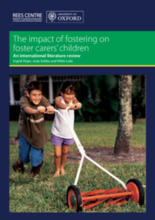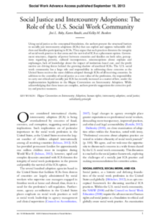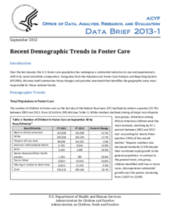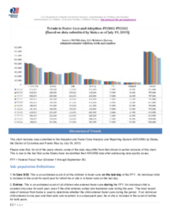Displaying 2081 - 2090 of 2215
This 6-minute video from the Center on the Developing Child at Harvard University explains the importance of human interaction with a caregiver to an infant’s brain development and the dangers of neglect to a child’s cognitive development, particularly the neglect that occurs in institutional settings.
This literature review by the Rees Centre for Research in Fostering and Education at the University of Oxford was undertaken to identify the ways in which carers’ children might be more effectively prepared and supported when their families are fostering.
This presentation, given at the Fifth Annual Interdisciplinary Conference on Human Trafficking 2013, describes a research paper that examines the connection between foster care and human trafficking in the United States with special emphasis on sex trafficking.
Using social justice as the conceptual foundation, the authors present the structural barriers to socially just intercountry adoptions (ICAs) that can exploit and oppress vulnerable children and families participating in ICAs. They argue that such practices threaten the integrity of social work practice in that arena and the survival of ICA as a placement option.
While adoptions to the United States are in steep decline, more U.S. children are being adopted abroad in countries such as the Netherlands. Most of the U.S.
This Washington Post article discusses the findings from a major report by the National Academy of Science on child abuse and neglect that found that advances in brain research showed that child abuse and neglect damages not only the way a developing child’s brain functions, but changes the actual structure of the brain itself.
Over the last decade, the U.S. foster care population has undergone a substantial reduction in size and experienced a shift in its racial and ethnic composition. Using data from the Adoption and Foster Care Analysis and Reporting System (AFCARS), this data brief summarizes those changes and provides new detail that identifies the geographic areas most responsible for these national trends.
This chart produced by the US Government's Children's Bureau includes data submitted to the Adoption and Foster Care Analysis and Reporting System (AFCARS) by US States, the District of Columbia and Puerto Rico by July 19, 2013.
This series of articles by Reuters investigates the disturbing practice of 'private re-homing' of adopted children in the USA, particularly affecting children adopted from overseas. 'Re-homing' also called 'adoption disruption' refers to adoptive parents abandoning their children and handing them out to other adults, often found through internet and social media fora, without any type of formal vetting or procedures.
This paper by the Brookings Center on Children and Families examines the scope of parenting interventions in the US that directly address poor parenting, as research has found how much parenting matters.






